Category Archive 'Christie’s'
01 Oct 2023

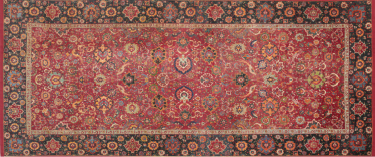
Safavid red-ground ‘Palmette and Bird’ carpet, circa 1565-75
Christie’s Auction 21892 London 26 – 25 OCT
Art of the Islamic and Indian Worlds including Rugs and Carpets, Lot 150:
A SAFAVID RED-GROUND ‘PALMETTE AND BIRD’ CARPET
POSSIBLY QAZVIN, NORTH PERSIA, CIRCA 1565-1575
Wool pile on a silk and cotton foundation, lacking outer stripe, areas of negligible wear, localised reweaves and restoration, sides rebound, an additional tape applied on all four sides
16ft.9in. x 7ft.3in. (517cm. x 225cm.)
PROVENANCE
Baron Edmond de Rothschild (1845-1934), Paris
With Colnaghi Oriental, London, circa 1975
With The Textile Gallery and Elio Cittone, Milan
Roberto Calvi, Milan
Canadian Collector, sold Christie’s London, 17 October 1996, lot 404
Private Collector, sold Sotheby’s New York, 20 September 2001, lot 221
Gordon P. Getty, sold Sotheby’s New York, 1 February 2013, lot 22, from where purchased by the present owner
Estimate
GBP 2,000,000 – GBP 3,000,000 — $2,393,400.00 – $3,590m100.00
See essay & video.
10 Oct 2021


A Corinthian helmet.
For any of my Hollywood movie star, hedge fund owning, kleptocrat dictator readers, Christie’s offers a collecting guide to a very interesting (and hideously expensive) hobby.
Ancient Greek helmets are a source of fascination for the modern audience as they provide a glimpse into this ancient culture and how their warriors functioned. Primarily, helmets were physical protection, worn in battles beginning in the Archaic period, together with greaves, chest plates and shields in many cases.
Helmets were also often symbols of status, with more ornate examples worn by an elite group. ‘Many buyers are looking to understand the ancient world through physical objects,’ says Hannah Fox Solomon, Antiquities Head of Sale and Specialist at Christie’s New York. Ancient helmets are just one example from which to do so.
The Illyrian helmet, one of two helmets to appear in the early 7th century BC, is the most common type. It is recognisable by its square face guard and pointed non-hinged cheek pieces, as well as the smooth dome featuring raised parallel ridges to which a crest made from horsehair, wood or leather would be pinned in place by a rivet at the crown.
The Corinthian helmet is the other 7th century helmet, with its characteristic almond-shaped eyes and rounded nose guard. ‘I think that the eyes are especially beautiful,’ says Solomon. ‘It’s an immediately recognisable shape: the domed head, the slightly flaring neck guard, the elongated eye openings . Aesthetically, it’s a beautiful form that has a lyrical nature.’
The Samno-Attic helmet, a later variation on the earlier types, features cheek pieces attached by hinges, and generally has a lighter feel with wider openings for the face and ears. They are often more ornate, some with moulded decoration and tall tubular plume-holders. Feathers were believed to be connected to Ares, the god of war, and scholars believe warriors wore feather atop their helmets as a means of intimidating the enemy. …
As with many objects on the market, condition has a major impact on the value of a helmet. ‘Some helmets are perfect, but some helmets have evidence of what we call the “death blow”,’ says Solomon, referring to damage on the side of the dome. ‘While I can only hypothesise whether or not that is true, occasionally you’ll find helmets with damage that makes you wonder if it was the result of battle.’
Importantly, however, not all damage is immediately visible. Often helmets need to be x-rayed in order to establish their condition. An x-ray can reveal cracks, areas lost or that have been filled with modern material, all of which affects the value.
RTWT
30 Mar 2021

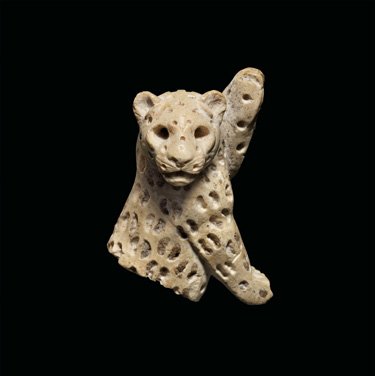
I receive a lot of email notices of auction sales. This morning an email circular from Christie’s had this fragment of a leopard serving as the illustration at the top. I liked it enough that I decided to look, unlikely as the chance would be, just in case it might be selling for only a few hundred dollars. I thought Karen would enjoy owning it as a decorative bibelot.
Clicking on the image, though, only took me to a sanctimonious pledge about carbon neutral auctioneering. Pah!
So I decided to capture the image and give it a search.
And I found it, as you see below.
I must admit: I have expensive tastes.
———————————————–
Via Alain R. Truong:
Lot 33. A Mesopotamian inlaid limestone leopard, Late Uruk – Jemdet Nasr period, circa 3300-2900 B.C.; 2 ¼ in. (5.8 cm.) high. Estimate GBP 150,000 – GBP 250,000. Price realised GBP 212,500.
Provenance: Private collection, New York, 1960s.
with Mathias Komor, New York.
Leo Mildenberg (1913-2001) collection, Zurich, acquired from the above in the mid-1970s.
A Peaceable Kingdom: The Leo Mildenberg Collection of Ancient Animals; Christie’s, London, 26-27 October 2004, lot 153.
Exhibited: The Cleveland Museum of Art, Animals in Ancient Art from the Leo Mildenberg Collection, 21 October-29 November 1981.
Munich, Prähistorische Staatssammlung; Mannheim, Reiss-Museum; Jerusalem, Bible Lands Museum; Bonn, Akademisches Kunstmuseum; Stendal, Winckelmann-Museum, Out of Noah’s Ark: Animals in Ancient Art from the Leo Mildenberg Collection, 11 October 1996-28 June 1999.
Published: A. P. Kozloff, ed., Animals in Ancient Art from the Leo Mildenberg Collection, Cleveland, 1981, no. 2.
P. E. Mottahedeh (ed.), Out of Noah’s Ark, Animals in Ancient Art from the Leo Mildenberg Collection, Bible Lands Museum, Jerusalem, 1997, no. 91.
Note: This Sumerian leopard with a ‘beauty spot’ (the remains of an ‘Egyptian blue’ inlay) on his cheek was affectionately named “Omar” by Mildenberg after the film star, Omar Sharif.
Only the upper section of the leopard is preserved, finely carved in the round in the heraldic rampant pose. While the body is shown in profile, the head is turned towards the viewer, snarling.
The mottling of the fur is rendered with a series of drilled holes, once inlaid with Egyptian blue (of which only one survives). The use of this typically Egyptian pigment is documented in Egypt from the Predynastic period, while contemporaneous similar-looking blue stones in Mesopotamia have been traditionally described as lapis lazuli. This single surviving inlay then represents one of the earliest appearances of Egyptian blue in the region.
According to Kozloff, the animal represented might be the Arabian leopard, now critically endangered and once found throughout the Arabian peninsula and the Sinai.
The use of coloured inlays to add detail to sculptures is well documented in Sumerian art. For a finely carved limestone bull showing drilled holes for now-lost inlays and also dated to the Jemdet Nasr Period, cf. Sumer. Assur. Babylone. Catalogue of the exhibition at the Musée du Petit Palais, 24 March – 14 June 1981, Paris, 1980, p. 38, no. 41.
Christie’s. Antiquities, London, 3 July 2019
15 Feb 2021

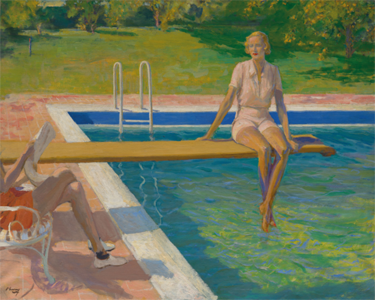
CHRISTIE’S March 1 | Live Auction 19783
Modern British Art Evening Sale
Lot 18 SIR JOHN LAVERY, R.A., R.S.A., R.H.A. (1856-1941)The Viscountess Castlerosse, Palm Springs
Estimate
GBP 400,000 – GBP 600,000 ($556,104.54 – $834,156.81)
Lavery had of course, already painted Doris Castlerosse’s portrait in 1933 when her marriage to Valentine Browne, Viscount Castlerosse, was already under strain. Having visited the Kenmare estate in 1913 to portray Lady Dorothy, the viscount’s sister, the Laverys were already well-known to the Castlerosse family. It is certainly the case that following their marriage in 1928, the two couples met socially (Mosley, 1956, p. 99). During a sitting however, Doris is reported to have asked the painter, ‘If I were divorced, it would not make any difference, would it, Sir John?’ Lavery’s diplomatic reply is unrecorded, but his wife, Hazel, was known to admire Doris’s ability to survive ‘rebuffs and unpopularity’ – the ‘same qualities as Ramsay MacDonald’ (George Malcolm Thomson, Lord Castlerosse, His Life and Times, 1973, Weidenfeld and Nicolson, pp. 110-111). A columnist of the period provided a vivid pen-portrait of Lady Castlerosse in the following terms:
‘She is well turned-out with no exaggeration. She has no habits. She does not pick the varnish off her fingernails. She does not twist her ring around her finger. She does not smoke cigarettes. She does not drink champagne. She does not disdain bad language. She makes full use of the common idiom in her speech’ (Mosley, 1956, p. 108; quoting from The Daily Express, 12 July 1932).
Born Doris Delevingne (1900-1942), daughter of a French lace and silk importer, Lady Castlerosse rose to fame in the twenties when sharing a flat with the actress, Gertrude Lawrence. She was regarded as a ‘gold-digger’ even though her husband, a failed banker, turned gossip columnist for the Sunday Express, had little money. At the time of her first sittings to Lavery she was having an affair with Randolph Churchill. Reports of a dalliance with his father, Winston, are complemented by his two portraits of Doris (David Coombs and Minnie S Churchill, Sir Winston Churchill, His Life and His Paintings, 2011, Ware House Publishing, cat. nos C152 & C158). In Hollywood in 1938, around the time she was sitting to Lavery on this second occasion, she was attending premieres and social events with Mr and Mrs Fred Astaire, Moira Shearer and Darryl Zanuck. Meeting the eighty-two-year-old painter in January 1938, at Palm Springs was likely, nevertheless, to have been a moment of calm in an otherwise full Hollywood diary.
Sittings in which the ‘model’s dais … was the spring-board’, were conducted by the pool at the Moroccan-style villa. Lavery composed the picture from two sketches using his portable easel. …
When revealed to the public, Lavery’s model, ‘pretty and very young-looking’, her legendary legs dangling over the pool, was almost carefree. Although she wears white court shoes in the photographs as The Sketch noted, the artist ‘has not forgotten to record the gay-lacquered toe-nails of Lady Castlerosse in his bathing portrait of her’ (‘What Every Woman Wants To Know’, The Sketch, 4 May 1938, p. 224). And as a master stroke, the artist includes the legs of the unseen, unidentified companion on the left of the canvas. A contemporary photograph which has recently come to light, indicates that these also belong to Castlerosse, snapped wearing a hairnet, shorts and plimsoles, during a break between the sittings (alternative theories, one advanced by Katharine FitzGerald, suggesting that the unseen observer was ‘a film director’, or another, that the legs belong to Doris’s brother, can be discounted).
Beside her, the present canvas is in progress and we can see that the ornate white garden chair, originally in the background, has been removed and adroitly placed under the figure reading, in place of the ugly wooden lounger. Lavery was clearly aware of the universal admiration for the famous Castlerosse limbs and secretly pays his own tribute, by painting them not once, but twice.
And of course, he had painted swimming pools before, in Florida and on the Riviera. The setting fascinated him. Art lovers today regard David Hockney as the ‘owner’ of Californian pool imagery. It may come as a surprise to some to discover that an aged Irish painter shared his enthusiasm and acted as its precedent.
——————————

Wikipedia bio
Affair with Winston Chuchill
24 Jan 2021

Lot 19
Depicting a man deep in thought, sitting on the ground with his chin resting on his folded arms, this pre-Columbian terracotta sculpture from Colima in Mexico dates from around 250 AD. The horn protruding from the figure’s head marks him out as a shaman
Estimate: €6,000-9,000 ($7,302.79-$10,954.18)
9 February, Paris
12 Dec 2020

——————

——————–

Christie’s
Sale 19017
Japanese and Korean Art
New York
22 September 2020
Lot 21
KATO GIZAN (B. 1968)
Jigen (Manifestation)
Signed Gizan and cursive monogram
Carved wood sculpture
43 3/8 in. (110.2 cm.) high without stand
With original metal stand
Estimate
USD 30,000 – USD 40,000
Price realised
USD 312,500
Via: Artemis Dreaming.
27 Sep 2020

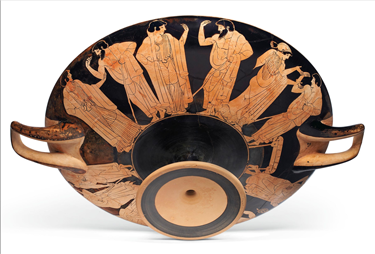
Attic red-figured kylix painting attributed to Makron and signed by Hieron as potter.
Christie’s SALE 18865
Antiquities
New York|13 October 2020
LOT42 –SOLD TO BENEFIT THE CLEVELAND MUSEUM OF ART
AN ATTIC RED-FIGURED KYLIX
ATTRIBUTED TO MAKRON AS PAINTER, SIGNED BY HIERON AS POTTER, CIRCA 490-480 B.C.
Estimate
USD 1,200,000 – USD 1,800,000
Christie’s Magazine speculates that this one may set a new record price for a Greek vase.
This Attic red-figured kylix — attributed to the painter Makron and of ‘outstanding provenance’ — could be about to eclipse a landmark figure set 20 years ago, says Harry Seymour
The year 490 BC was a memorable one for the people of Athens: 10,000 of the city’s soldiers crushed the much larger Persian army of Darius the Great; work commenced on the first Temple of Athena Parthenos on the Acropolis; and the modern marathon was born when a messenger with good news supposedly ran 26 miles to the city before dropping dead.
It is also thought to be the year in which an artist known as Makron began his decade-long career painting ceramics in the Kerameikos — the potters’ quarter — in Athens.
‘He soon established himself as one of the best painters of his generation,’ says G. Max Bernheimer, international head of Antiquities at Christie’s. ‘And this Attic red-figured wine cup — offered on 13 October at Christie’s in New York — is the best example by the fabled artist to come to auction in decades.’
Makron worked in a relatively new style known as ‘red-figure’, which involved creating shapes from negative space against a painted background. Details were then added with a brush and slip. This technique replaced the predominant ‘black-figure’ style, which required detail to be incised into painted figures, and made portraying pictorial depth tricky.
Makron’s name survives today thanks to a single signed work, a skyphos now in the Museum of Fine Arts in Boston, which features the words ‘Makron drew me’ painted on one handle.
The underside of one of the cup’s handles was inscribed by the potter with the words, ‘Hieron made me’
In the 20th century, however, a further 350 ceramics (including this one) were attributed to Makron by the Oxford University professor Sir John Beazley (1885-1970). Beazley catalogued thousands of Greek vases by studying each painter’s style in minute detail. In the case of Makron, his characters feature distinctive round heads with flat tops and drapery folds drawn with great finesse.
Today, nearly all of Makron’s vases are housed in major institutions, including the Met, the Louvre, the British Museum and the Getty. According to Bernheimer, ‘Hardly any are left in private hands, which makes this one all the more desirable to collectors.’
RTWT
09 Aug 2020


Sold 25 November 2017
CHU TEH-CHUN (ZHU DEQUN, FRANCE/CHINA, 1920-2014)
Poussée Cristalline (Unrevealed Crystal)
Price realised
HKD 22,300,000 ($2,899,000)
Estimate
HKD 10,000,000 – HKD 16,000,000
—————————-
Wikipedia:
Chu Teh-Chun or Zhu Dequn (24 October 1920 – 26 March 2014) was a Chinese-French abstract painter acclaimed for his pioneering style integrating traditional Chinese painting techniques with Western abstract art. …
Chu Teh-Chun was born in 1920 in the town of Baitu in Xiao County, which was then in Jiangsu province but now part of Anhui province. In 1935 he entered the National School of Fine Arts (now China Academy of Art) in Hangzhou, Zhejiang, graduating in 1941. At the school he studied Chinese painting under Pan Tianshou and Western art under Fang Ganmin and Wu Dayu, who were prominent Chinese artists trained in France. …
In 1945 Chu became a faculty member of the architecture department of the National Central University in Nanjing, then China’s capital. With the communist victory in mainland China, Chu moved to Taiwan in 1949, joining the National Taiwan Normal University where he taught Western-style painting. He moved to Paris in 1955, where he lived for the rest of his life. He became a French citizen in 1980, and a member of the Académie des Beaux-Arts in 1997. …
Inspired by Nicolas de Staël’s abstract landscape paintings, Chu abandoned figurative painting and adopted a unique style using bold strokes of colour which evoked Chinese calligraphy. His new style was immediately successful. In 1964, an exhibition of his works at the Carnegie Museum of Art in Pittsburgh brought him international fame. On 17 December 1997, Chu was elected a member of the Académie des Beaux-Arts of France, the first Frenchman of Chinese origin to be chosen. He was also made a Chevalier de l’Ordre des Palmes Académiques and Chevalier de la Légion d’Honneur in 2001. His paintings are now in the permanent collections of more than 50 museums all over the world. Major exhibitions of his work were held at the Shanghai Art Museum in 2005 and Beijing’s National Art Museum of China in 2010.
27 Jul 2020


A tourmaline and diamond flower brooch, by JAR. Designed as two green and pink tourmaline poppy flowerhead and bud, linked by a green tourmaline scrolling stem centering upon a pear-shaped diamond. Sold for CHF 1,179,000 on 14 May 2012 at Christie’s in Geneva.
Christie’s monthly magazine has a feature on a jeweler you and I can start patronizing for gifts for the little woman just as soon as we sell off our 50,000-acre cattle ranches.
Nice stuff, though.
Joel Arthur Rosenthal produces only around 70 imaginative, meticulously crafted pieces a year, making them highly sought-after by movie stars, tastemakers and collectors the world over
There’s no shop sign or window display at 7 Place Vendôme — nothing that hints at the brilliance within beyond three discreet letters, JAR. Yet for jewellery collectors, this is a place of pilgrimage: the store of the acclaimed contemporary jewellery designer, Joel Arthur Rosenthal.
Born in New York City in 1943, Rosenthal graduated in art history and philosophy at Harvard before moving to Paris. There, he opened a needlepoint shop, where his experiments with unusual colours of yarn attracted the custom of designers for Hermès and Valentino. After working with Bulgari in New York, he returned to Paris, opening his own jewellery store with his partner, Pierre Jeannet, in 1977.
Diamond and coloured diamond Trellis rarrings, JAR. Estimate $150,000-200,000. Offered in Magnificent Jewels on 29 July 2020 at Christie’s in New York
Diamond and coloured diamond ‘Trellis’ rarrings, JAR. Estimate: $150,000-200,000. Offered in Magnificent Jewels on 29 July 2020 at Christie’s in New York
JAR, as he is generally known, is celebrated for his creativity and his craftsmanship. He pairs unusual gemstones with non-traditional materials and has a daring way with colour and proportion. The quality of his work recalls the jewellery of the 18th and 19th centuries. In 2013, he was the first living ‘artist of gems’ to be honoured with a retrospective at the New York Metropolitan Museum of Art.
JAR only produces some 70 pieces a year. His ability to create jewels of unusual dynamism and architectural depth has made him a favourite with style icons, tastemakers and collectors the world over.
RTWT
20 Feb 2019
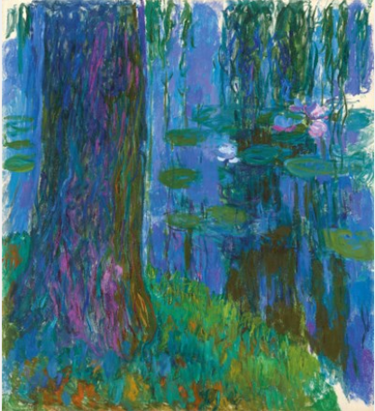
At Christie’s February 27th Sale:
Lot 11
— Claude Monet (1840-1926)
Saule pleureur et bassin aux nymphéas [Weeping willow and pond with water lilies]
stamped with signature ‘Claude Monet’ (Lugt 1819b; lower left)
oil on canvas
78 1/2 x 70 3/4 in. (199 x 180 cm.)
Painted in Giverny in 1916-1919.
Estimate “upon request,” meaning: If you have to ask, you can’t afford it.
20 Nov 2018

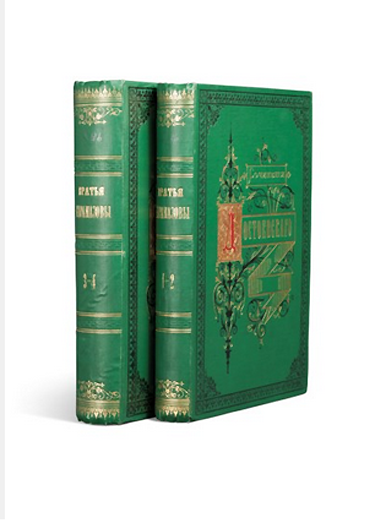
Christie’s — Sale 17162 — Russian Literary First Editions & Manuscripts: Highlights from the R. Eden Martin Collection, London, 28 November 2018.
Lot 68
DOSTOEVSKY, Fyodor (1821-1881). Brat’ia Karamazovy. [The Brothers Karamazov.] St Petersburg: Brothers Panteleev, 1881 [but December 1880].
Estimate
GBP 22,000 – GBP 30,000
(USD 28,754 – USD 39,210)
The first edition of Dostoevsky’s masterpiece, in a superb contemporary cloth binding – arguably the most attractive surviving copy of ‘the most magnificent novel ever written’ (Freud). Dostoevsky’s lifetime publications were typically issued in sober cloth bindings; this colourful and decorative binding is otherwise unrecorded and may have been commissioned by the publisher for presentation. Karamazov in any contemporary cloth is very rare; RBH and ABPC record only one: a set with only volume 1 bound in cloth (sold, Christie’s, 21 May 2014, lot 56). Kilgour 286.
Four parts in two volumes, octavo (210 x 143mm). With the half-titles and the final blank in vol. 1 (occasional light scattered spotting, mainly to the edges and some margins.) Contemporary decorative green cloth by V. Kiun with his printed label in the first volume; front covers with a large decorative block in gold, black and red incorporating the text ‘Sochineniia Dostoevskago’ [Works of Dostoevsky]; covers with a black foliate border; spines titled in gilt and tooled in gilt and blind; plain endpapers (negligible rubbing); custom brown morocco backed clamshell case. Provenance: ‘I 36’ (penciled press mark).
17 Nov 2017

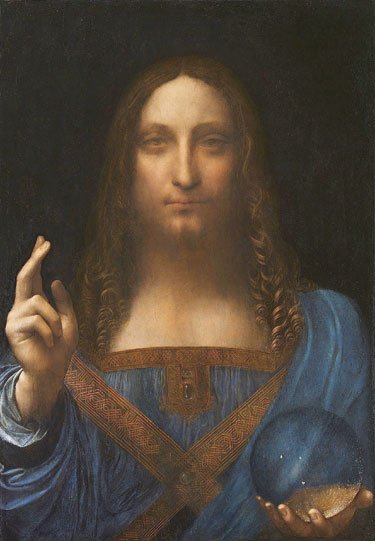
New York Times:
After 19 minutes of dueling, with four bidders on the telephone and one in the room, Leonardo da Vinci’s “Salvator Mundi†sold on Wednesday night for $450.3 million with fees, shattering the high for any work of art sold at auction. It far surpassed Picasso’s “Women of Algiers,†which fetched $179.4 million at Christie’s in May 2015. The buyer was not immediately disclosed.
There were gasps throughout the sale, as the bids climbed by tens of millions up to $225 million, by fives up to $260 million, and then by twos. As the bidding slowed, and a buyer pondered the next multi-million-dollar increment, Jussi Pylkkanen, the auctioneer, said, “It’s an historic moment; we’ll wait.â€
Toward the end, Alex Rotter, Christie’s co-chairman of postwar and contemporary art, who represented a buyer on the phone, made two big jumps to shake off one last rival bid from Francis de Poortere, Christie’s head of old master paintings.
The price is all the more remarkable at a time when the old masters market is contracting, because of limited supply and collectors’ penchant for contemporary art.
And to critics, the astronomical sale attests to something else — the degree to which salesmanship has come to drive and dominate the conversation about art and its value. Some art experts pointed to the painting’s damaged condition and its questionable authenticity.
“This was a thumping epic triumph of branding and desire over connoisseurship and reality,†said Todd Levin, a New York art adviser.
Christie’s marketing campaign was perhaps unprecedented in the art world; it was the first time the auction house went so far as to enlist an outside agency to advertise the work. Christie’s also released a video that included top executives pitching the painting to Hong Kong clients as “the holy grail of our business†and likening it to “the discovery of a new planet.†Christie’s called the work “the Last da Vinci,†the only known painting by the Renaissance master still in a private collection (some 15 others are in museums).
“It’s been a brilliant marketing campaign,†said Alan Hobart, director of the Pyms Gallery in London, who has acquired museum-quality artworks across a range of historical periods for the British businessman and collector Graham Kirkham. “This is going to be the future.â€
RTWT
—————————
—————————
Times Critic Jason Farago (speaking on behalf of the Establishment) does not like the painting or its buyer.
You can’t put a price on beauty; you can put a price on a name. When the National Gallery in London exhibited a painting of Christ in 2011 as a heretofore lost work by Leonardo da Vinci, the surprise in art historical circles was exceeded only by the salivating of dealers and auctioneers.
The painting, “Salvator Mundi,†is the only Leonardo in private hands, and was brought to market by the family trust of Dmitry E. Rybolovlev, the Russian billionaire entangled in an epic multinational lawsuit with his former dealer, Yves Bouvier. On Wednesday night, at Christie’s postwar and contemporary sale (in which it was incongruously included to reach bidders beyond Renaissance connoisseurs), the Leonardo sold for a shocking $450.3 million, the highest price ever paid for a work of art at auction. Worth it? Well, what are you buying: the painting or the brand?
The painting, when purchased at an estate sale in 2005 for less than $10,000, was initially considered a copy of a lost Leonardo, completed around 1500 and once in the collection of Charles I of England. Over time, its wood surface became cracked and chafed, and it had been crudely overpainted, as an image in the sale catalog shows. Cleaned by the conservator Dianne Dwyer Modestini, the painting now appears in some limbo state between its original form and an exacting, though partially imagined, rehabilitation.
Authentication is a serious but subjective business. I’m not the man to affirm or reject its attribution; it is accepted as a Leonardo by many serious scholars, though not all. I can say, however, what I felt I was looking at when I took my place among the crowds who’d queued an hour or more to behold and endlessly photograph “Salvator Mundiâ€: a proficient but not especially distinguished religious picture from turn-of-the-16th-century Lombardy, put through a wringer of restorations.
RTWT
Your are browsing
the Archives of Never Yet Melted in the 'Christie’s' Category.
/div>

Feeds
|


















